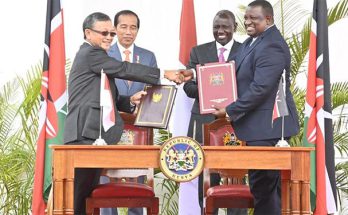 When Laduma Ngxokolo, a textile graduate from the Nelson Mandela Metropolitan University (NMMU), decided to create a range of men’s knitwear as part of a research project for his studies, he had no idea his love of knitting would cause such a stir in the fashion industry.
When Laduma Ngxokolo, a textile graduate from the Nelson Mandela Metropolitan University (NMMU), decided to create a range of men’s knitwear as part of a research project for his studies, he had no idea his love of knitting would cause such a stir in the fashion industry.
“It feels like a dream some days,” Ngxokolo says when asked how it feels to go from being a student to an internationally acclaimed men’s knitwear designer.
Ngxokolo’s distinctive pure kid mohair and Merino wool jerseys celebrate traditional Xhosa heritage and have put the spotlight on South African design talent.
The fashion world first took notice of Ngxokolo’s designs when he entered an international competition initiated by the Society of Dyes and Colourists.
He won the national leg of the competition, earning him a trip to London, some money and the Veronica Bell Trophy.
He then went on to compete against eight other countries and, much to his surprise, he was named the overall winner.
Since then, one of his knitwear pieces was nominated for the 2011 Design Indaba Most Beautiful Objects in South Africa competition.
Research project with a difference
Although wool and mohair garments have come to be associated with high-end fashion, Ngxokolo’s original intention for the jerseys was far much more practical.
“For my BTech research project, I wanted to develop a Xhosa-inspired range of knitwear for amakrwala (Xhosa for new initiates),” he says.
In Eastern Cape Xhosa communities, boys between the age of 18 and 23 undergo circumcision as part of a manhood initiation ritual. After initiates return home from initiation school, they are guided through a six-month process where their elders teach them manhood protocol. Xhosa initiates are traditionally called amakrwala during this process.
Before amakrwala attend circumcision school, all their old clothes are given away, which symbolises the end of boyhood. Their parents have to buy them new clothing, including high-quality men’s knitwear. This is where Ngxokolo saw a gap in the market.
Amakrwala buy imported knitwear brands, but he says these bear no resemblance to Xhosa traditions. For this reason, Ngxokolo wanted to develop knitwear using only traditional Xhosa designs and colours.
He says that amakrwala are influenced by urban, western styles and it was important to create contemporary garments that are still in keeping with Xhosa culture. He also wanted to use long-lasting fibres. “One of my main considerations was to use high-quality materials so that the items could be passed down to the next generation,” Ngxokolo adds.
Finding design inspiration
The designs and patterns for each jersey are well researched. “I draw inspiration from traditional Xhosa beadwork. I add my own interpretation of each design and then develop the knitting motifs. This makes each jersey distinctive,” he says.
The recurring zig-zag, arrow and diamond motifs found in Xhosa beadwork designs are structured geometrically, making them ideal for knitting.
There is no sense of mass-production associated with Ngxokolo’s garments. Designing, sourcing of wool, dyeing and production can take up to a month. Once he has found motifs that he likes, he develops computer-aided knitwear designs resembling those of traditional Xhosa beadwork.
Colour is important in Xhosa culture and the palette of each jersey is well thought-out.
“Orange is one of my favourite colours. I select light, medium and dark colours so that they can be mixed and matched to form exciting colour combinations,” he says. The patterns on each jersey are attractively arranged, using various shades of red, orange, green, brown and even a touch of blue.
Natural fibres
Ngxokolo is a purist and big supporter of using local and natural fibre in fashion. “Consumers are becoming more discerning about what they buy and wear and natural fibres are much more popular these days,” he says.
All his jerseys are knitted using only pure wool and mohair from the Eastern Cape. “I enjoy working with mohair and wool because both fibres are durable, breathable and they have good colour fastness.”
The Eastern Cape is a leading producer of high-quality wool and mohair, producing the majority of the world’s mohair. The absence of a thriving textile industry means the majority of mohair is exported.
Ngxokolo says that in utilising the fibre, he can indirectly contribute to the sustainability of local farmers and small-scale black community farmers.
Building a business
Thanks to the NMMU incubator initiative, a programme that helps promising graduates turn their creative ideas into viable businesses, Ngxokolo is on his way to building a thriving business.
The NMMU Fashion and Textile Department provides him with a rent-free workshop and he is training four apprentice knitters to help with the growing demand for his knitwear. Ngxokolo also hopes to launch a female knitwear range in early 2012.
The response to his work has been overwhelming and he says he has his mother to thank for first getting him interested in knitting. “She taught me everything I know,” Ngxokolo says.




Comments are closed.